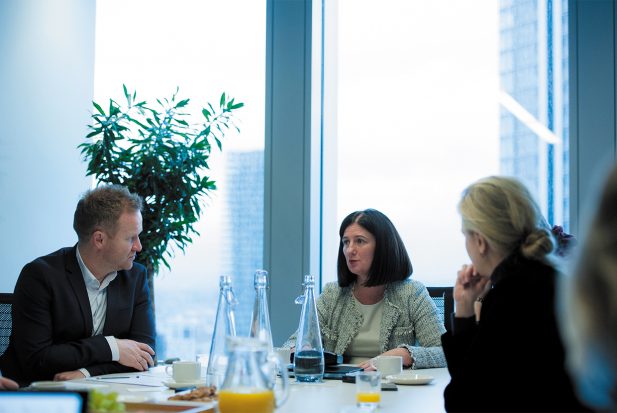
Mastercard and GTR hosted a roundtable event to discuss the role of technology, partnerships and ecosystems in unlocking trade finance and facilitating financial inclusion.
Roundtable participants:
- Tor Stian Kjøllesdal, vice-president finance, CFO FIN internal treasury, Equinor
- Shannon Manders, editorial director, GTR (chair)
- Mirka Skrzypczak, head of working capital and trade products, NatWest
- David Sutter, chief strategy officer, TradeIX
- Claire Thompson, executive vice-president, enterprise partnerships, Mastercard
Thompson: We are all partners who are actively working today to drive new paradigms in trade. At Mastercard, we firmly believe in doing well by doing good, and advancing inclusive trade is a core part of this. What we are doing ultimately is driving the democratisation of trade, access to funding and growing the economy for those that need it most, as well as keeping the lifeblood of the global economy going. We know that we will all only win out of this if we come together and stay together to drive success on a long-term sustainable basis.
GTR: What is your view on the overall health of the trade finance ecosystem as it exists today? Are people doing well by doing good?
Skrzypczak: The biggest challenge nowadays when it comes to trade is that it’s very much a siloed proposition. I do not believe that access to trade instruments is available to everybody. I also don’t believe it penetrates down to the end of supply chains where it’s needed the most. When you think about doing things well and doing good, we have seen fantastic initiatives in the industry where such activities bear fruit, such as around the provenance of goods from less developed countries to our supermarket shelves. This is fantastic, but it’s still not enough.
We need to strive to create a greater network effect and connectivity between various providers and start building lasting partnerships where we can actually create a proper enriched proposition, not just for the big corporates, but also for the supply chains of those corporates.
Sutter: I think it is doing better than it has been in the past, but it still has quite a long way to go. One big precipitous change that has occurred is the way we as an industry are now thinking about how to solve our problems. Traditionally, when we looked at the technical and business issues in trade, people were looking at them only at a firm-wide level. Just unilaterally, within their four walls. But now, people are thinking about how to drive efficiencies and solve challenges at the market-wide level. So, they are attacking structural issues that by their very nature require structural solutions, which requires an industry-wide, collaborative effort.
That shift in mentality away from firm-specific problem-solving and the inability or unwillingness to collaborate, even when it involves – or especially when it involves – collaborating with some of your competitors, has really opened up an entire wave of innovation and focus on digitisation at the market-wide level.
Today the entire trade ecosystem is really focused on the creation of a new digital infrastructure that ultimately will lay the basis for solving some of these fundamental, structural issues that we have in trade, like the SME trade finance gap, but also a whole host of other issues. But we are not there yet. So, the shift in thinking has precipitated a lot of very promising initiatives, but those initiatives are still relatively young in terms of their drive to be ubiquitous.
GTR: What role has the technology itself played in that shift in mentality?
Sutter: I might be biased because of my background, but blockchain-based technologies are, by their very nature, networks. And networks require network effects. They don’t work without collaboration. So, the technology has precipitated a shift in thinking, where you have bankers shifting towards becoming technologists, and you have technologists shifting towards becoming bankers. And that sort of clash in the middle has created some very interesting dynamics. But the technology, blockchain, has really opened everyone’s eyes to how collaboration and networks can solve market-wide structural issues, especially in trade.
GTR: From a corporate perspective, are you seeing a similar change in dynamics in the trade finance market?
Kjøllesdal: We see a change, or at least the start of the change. For a company like ours, trade finance as it has developed over many years serves its purpose. Access or flexibility is an issue for many people and many corporates. We have, given the volumes that we trade, been able to build up an organisation with both the competence and capacity to manage the complexity that trade finance has today. We also have access to banks, which you need to perform these tasks, and of course, it is still heavily paper-based. But there are a lot of promising changes on the way, and we invest in and are really interested in connecting to those, and really look forward to seeing how this will develop.
From the perspective of a global market player, I think we saw some positive developments some years back, but they have all been eaten up by the compliance requirements that have been put on top of the whole treasury function I am running. We spend so much time on the regulatory perspectives for each activity that we do, that, in a way, the efficiency gains from technology developments are erased. I also see that it is difficult to put in place networks that actually comply with the regulatory requirements. So that is still a concern.
GTR: Where do we want to get to? What does a trade ecosystem utopia look like?
Sutter: I have always been a fan of science fiction, but I think this fiction will become a reality sooner than we think – and that is the advent of fully autonomous trade and supply chains. If you look at global supply chains, both the physical and the financial supply chain, the components are being built right now to, firstly, connect the two, but then also, as a next step, automate them entirely from end to end. And if you look at some of the initiatives with self-driving container ships, autonomous delivery drones, this stuff sounds stranger than fiction, but it is happening right now.
Skrzypczak: We are also entering the next leap in technology: we are currently in a period when a lot of new technologies are coming together. We have blockchain, AI, quantum computing, and far more advanced cloud computing and API connectivity. So now we can just start plugging stuff in.
To the point about compliance, again, we are learning, but AI is a great example where you can use technology to review documents. With the ability of AI to read unstructured data and come up with the same conclusion as a human being would – and the same applies to sanctions screening – we are starting to win the battle. We are starting to push the process forward, and working with one another in doing so.
I am a strong believer that if you learn something the hard way about these new technologies, keeping it just for yourself is not a good idea. Sharing it with other people who can help you create that network is definitely best practice. This is different from the way we used to think a few years back. So, we are opening ourselves up. We are becoming more understanding of the fact that you cannot do it alone – you have to work with partnerships.
But also, when you think about our customer base, my customers don’t just want me to sell them bank products any more. They don’t care about that. They want the experience. They want someone that becomes their partner and thinks like they do in terms of their strategic development, helps them connect their supply chains, and thinks about sustainability, the environment, and responsible growth. That is not easy to achieve on your own, so you have to do it together. And I think it is exciting to do so.
GTR: We have talked about this greater network effect. Can you give some specific success stories of where you have seen this working recently?
Thompson: We have been running the Mastercard network for over 50 years. We have taken a lot of learnings from that. We have not run that global payments network by ourselves; we have done that with our partners: banks, merchants, and governments. Taking that approach into B2B, this is what we are doing with our partners around this table and across different B2B networks.
Along this journey, we realised: don’t we need an information set around all the businesses that operate around the world? That led us to creating the Mastercard Track global trade directory. There, we have about 210 million of the 265 million businesses around the world registered – each of those companies have a digital ID that they can also use – for example – across the whole of the Marco Polo network, which means it can be used to bring networks together. What is important is that if I am going to trade with you, I need to trust you. So, from there, it is really about adding information which creates trust, whether it is around compliance, or credit scoring. So really what we are trying to do is to enable that scale, achieve networks, and ultimately advance inclusive trade. We want to drive a trusted ID which will facilitate the growth of trade.
Skrzypczak: If I am using Mastercard to enhance supplier onboarding, for example, in my supply chain finance programmes, then I am using the trust that Mastercard gained. I don’t need to start from scratch. Suddenly, the trust does not only apply to my domestic supplier base, where it is very slick and very online and very digitised. I can use the Mastercard network to be able to onboard suppliers from all over the world.
As a bank we are focusing on UK plc, and they need suppliers from all over the world to be successful. So, using Mastercard Track to be able to onboard those suppliers onto our programmes, that is already a tick. By the way, my platform for supply chain finance will be, by coincidence, Marco Polo. Marco Polo and Track are part of the same data flows.
To the point about compliance, you need to make sure you are still AML compliant – so this is where the network comes in. My client is part of the Mastercard Track of Marco Polo. So, you start having that connectivity without even thinking about it, and that is the magic. We want people to start connecting when they want to connect. We want people to consume the services for B2B when they need to consume them. And this is a really great example of how we try to bring it together.
GTR: Tor, from your perspective, does this solve your pain points from a corporate point of view and what is your view on the practicalities of getting involved in this network?
Kjøllesdal: That is the direction we need to move to and it will definitely solve the inefficiency issues that we currently have. We are also part of an energy consortium called Vakt where we are together with peers and banks, so how those things fit together is key for us. One challenge is the speed of the adoption that we can have for the community as a total. That will be a key for success.
GTR: As the industry looks to drive more partnerships, it would be good to identify the problems and where they are most acute. What are the key challenges in trade today, and how can they be solved by this new network effect?
Skrzypczak: Lack of trust. That is for sure. Paper. That is not disappearing.
Thompson: And paper means that you can’t be interoperable.
Skrzypczak: I think there are still too many middleman parties. One really great example is where Sainsbury’s and Unilever used Halotrade for the tea farmers in Malawi. Through that process, not only were they able to make sure that farmers got a fair price for their tea, but they were also able to cut out some of the middlemen.
If you look at trade flows now and how many parties play a part, it is ridiculous. There are very clear bottlenecks, and those bottlenecks come down to documentation, paperwork, and the lack of trust. There are certain countries which are less advanced than others. Corruption is very much present. So, you have a lot of issues around trust that are linked to geopolitical aspects of certain jurisdictions. But trade prevails. Trade has to find its way.
Thompson: If you think of the global financial liquidity crisis, the level of funding available globally has declined because of that. We touched on it a little bit earlier in terms of the cost of doing business having increased because of compliance and regulation. The overall outcome is that there is less funding available and obviously that is going to have a more dramatic effect on the SMEs. The Asian Development Bank has said that requests for trade finance to the magnitude of US$1.5tn are being rejected. For small companies almost half of their requests are being turned down. So, we are still solving for a funding challenge.
Sutter: From a technologist perspective, the biggest challenge is not just legacy software systems, but the way that they have been built over the last 30 years. They have created this tremendously fragile and very difficult to deal with sort of house of cards, where you have some mainframe that has been installed in the 1980s. When it was upgraded, someone bolted something on top of that, and then when it needed upgrading again, someone bolted something on top of that.
You end up with this extremely complex web of dependencies flowing all the way down to a mainframe that is written in a programming language so old that there is a group of retirees who make a living because they are the only people still alive who know how to use it. So, untangling that and going digital, without hindering the new digital solution because of the limitations of the old legacy, is extremely challenging.
If you look at industries where digital has been extremely fast and easy, it is in areas where there was nothing before. Look at emerging markets with broadband and cellular connectivity. They did not have landlines so they were able to leapfrog the landlines and physical infrastructure and went straight to mobile, and there was no legacy to deal with so they were able to move extremely quickly. But in the world of trade, unfortunately, corporates, banks, and other service providers have terribly complex legacy software systems that make it challenging and slow and costly to change them.
GTR: If we look at the challenges faced by SMEs in particular, in addition to the lack of funding that Claire talked about, what else are their pain points?
Sutter: From an SME perspective, it is a huge issue, but the causes are pretty straightforward. One is the inability to accurately assess risk, and the way to change that is better access to data. The second is that it is too costly to service them compared to the profit or revenue that they will make, just because their volumes are smaller. So, it is not that we can’t service them, it is just that they are too expensive and we can’t accurately assess their risk. Digital solutions that drive down the cost of servicing each SME per unit and also allow a more accurate assessment of risk will change the cost-benefit analysis to where it is economically profitable to actually do business with that company. The moment that we reach that crossover point, you will see that gap starts to evaporate. But it is going to take time to get there.
Thompson: 90% of the companies in the world are classified as SMEs. And they employ half of the world’s labour force. So, in doing all of this, we clearly have got to set our sights on solving the problem, because that is not an insignificant portion of what global trade is really all about. In a 2017 report the IFC found that 40% of formal MSMEs in developing economies, or 65 million enterprises, have an unmet financing need of US$5.2tn every year.
GTR: Talking specifically in terms of access to finance, what are some of the innovative ways that lending is being unlocked?
Thompson: I can start with an example. If you think about the micro merchants, the typical storeowners that you see in developing markets, they use cash. But cash gives you no credit history. It gives you no trading history. So, how do you really access the throughput of goods that you want to sell in your store? We developed a programme called Jaza Duka, which is Swahili for “fill your store”. We took Mastercard’s technology platforms, the financing available from a local bank in Kenya, and we worked with Unilever to sponsor that programme to track the throughput of goods, or how many goods are actually being bought and sold. That then became the proxy for the credit history and the performance history, and then basically the bank was able to lend on the back of that.
Sutter: One of the best ways to enhance the credit of the small supplier who doesn’t have access to financing is to involve the creditworthy buyer in the orchestration, because, by doing that, you are able to leverage the strong creditworthy buyer to unlock liquidity for the suppliers. Obviously, we all know, supply chain finance or payables finance are products that are becoming increasingly popular, but the issue has been that, to date, those programmes are only really confined to the tier one suppliers. The only way to go further down into that long tail to the suppliers that typically need access to credit the most, is technology. By streamlining the onboarding process, by providing more data to evidence the linkage between the tier one, two, three and four suppliers, it ultimately is a better value proposition to the buyer, but really the most important outcome is that you are unlocking liquidity for that supplier base.
Skrzypczak: That is why we are doing what we are doing with Marco Polo. We decided to provide a platform that will allow us to penetrate down to the supplier end, and the technology enables us to do that, because it is very cost efficient to spin off a new node for a supplier. And then combining that with Track, I can add the trust, so you start seeing the benefits, and all those challenges that we are facing start disappearing. We are not going to go straight to the long tail, but moving to tier two or tier three is a massive achievement already. And that definitely will give us the capability from day one when we are up and running.
Sutter: One of the key pieces to going into the tail is the KYC and identity verification of that small supplier, which is one of the strong value propositions of Mastercard Track. The aggregation of data that they are providing in a digital manner can be laced in via APIs to the actual onboarding workflows for the bank. It really does reduce the biggest pain point from a supplier onboarding perspective.
GTR: Let’s talk about the gender trade finance gap in particular. In Africa alone, there is a US$42bn gap between men and women in terms of access to financing. Is this something that plays into the conversations that you are having?
Skrzypczak: Look no further than the government-commissioned Rose Review, which is about female entrepreneurs and the barriers for them to expand their businesses. On the back of that, we launched a campaign called Family First, where we have come up with clever ways of helping businesses run by female entrepreneurs to access finance.
We’re looking through various lenses at this, but it is about how we as financial institutions should be changing our thinking and also lobbying the government to helping to create those circumstances to close the gender gap in this space.
Thompson: We have just released the third edition of the Mastercard Index of Women’s Entrepreneurship and we are now spanning about 58 economies, which is 80% of the female labour force. It is still developed economies where the female entrepreneurs are the most successful, but that is not consistent across the board.
There are many findings, but we are often seeing that it is not just the wealth-based advanced economies where females are setting up businesses and being successful, but also from a needs-based economy, where women have to set up businesses to survive. We are not doing this research just to observe the problem. The reason we are doing the research is so that our action-based activity is targeted at the most needed areas.
Kjøllesdal: This is a bit of a different angle, but coming from our industry which is in the business of providing energy to the world, one of our purposes is to progress society and with that we also need to make sure that we bring in values and commitments. Diversity and inclusion is a key pillar of how we run the company. We work with suppliers, with communities and business partners, focusing on bringing our values and our human rights standards through the supply chain.
With that, we hope to generate more business that also needs to be financed. We don’t work directly with small companies all over the globe, but indirectly, they are affected by what we do. We say that profit without purpose is meaningless, but of course, we cannot have a purpose without profit, either, so we need both, and that is a key parameter for us. And the overall values and compliance is in a way our licence to operate, so we always need to comply with that.
GTR: How will networks work together going forward?
Skrzypczak: Distributed ledger technology by its nature is decentralised. It is very much akin to the internet of 1994. When we had it, there was zero connectivity. You could not have an email account with one provider and I could not email you if you were not part of the same provider. It took us some years before we had SMTP, which was a standard format of being able to exchange emails through multiple providers. And I think that is exactly what we are going to need for the new technologies. It is not just about DLT; it is about other technologies outside of that. The challenge we are going to have is integrating those new technologies within our old technologies. But in terms of the connectivity of the new networks between themselves, I think that is easier.
Sutter: Interoperability is driven primarily by standards. You can look across society and see examples where standards changed our lives. Greenwich Mean Time saw the standardisation of time zones, which allowed commerce to occur. Standard gauging and sizing allowed us to connect railways across land. Look at container ships, and then the internet, and cell phones. Everything that has really revolutionised society from a technological standpoint has been driven by standards-based interoperability.
This is why we’re a founding member of an industry-wide standards initiative called the Universal Trade Network, which GTR has covered pretty extensively, which was given a mandate by the banking industry to drive standards-based interoperability between the various digital initiatives to ensure that we don’t end up with 50 or 60 new digital islands. That initiative has recently been taken over by the ICC and been rebranded as the digital standards initiative (DSI), which really brings it the legitimacy and objectivity that any type of standard-setting organisation needs.
Skrzypczak: Our problem in the past was that when we were thinking about standards in trade, it was, how do we make every single document look the same. Or how do we make every document have the same elements? In technology, the biggest mistake we could do is digitise the status quo. With this new interoperability, the standards are technical and technology-based.
Sutter: When you send an email, you don’t have the same message each time. You are standardising the transport layer and how that is structured and encoded over the wire. So, really, we are focused on structuring the transport layer and not the inputs and outputs. They can be multivariable, but the transport needs to be standard.
Kjøllesdal: I am happy that you find it easy, because from a corporate perspective, it is not easy. Of course we see the opportunity, but there are a lot of options as well where you have a lot of different platforms, networks and solutions depending on how you connect to your own systems. So, that is a challenge. When you do some technology investments, it comes with a cost, and you need to identify the business cases for that specific component. Particularly for us, we find it difficult to really know which network or technology is worthwhile investing in.
GTR: So, what do you say to somebody like Tor who has that problem of identifying which network to try out?
Sutter: I think there is an important point to make about whose job it is to solve Tor’s problem. And if you look at other industries, it really is the responsibility of the service providers to drive standards that benefit the end user. I read about the creation of HDMI. It is very interesting, because you have major rivals like Samsung, Sony, LG who came together and said, we are going to compete with each other, but ultimately we don’t want our clients to have to carry around 10 different cords for every different TV that they have. And the same with GSM and TDMA in the mobile space. Big rivals came together to make sure that I don’t have to carry an Apple, a Samsung, and a Windows phone to talk to people with Apple, Samsung and Windows phones. I have one phone. For corporates, I think it’s financial institutions, but also technology providers and service providers like logistics companies whose remit it is to actually come together and set the standards ultimately to people like Tor’s benefit.
GTR: What is everyone excited about for 2020?
Kjøllesdal: We want to see progress and accelerate the progress on the development that we are already seeing. To give one example, crude oil trading, which is a core trading for us, has been traditionally very manual, complex, and cumbersome, with a lot of paperwork including everything from letter of credit to invoicing certificates all around the world, sent by fax, maybe emails if we are lucky. We are now live with Vakt on blockchain-based technology for trade in the North Sea between major oil and gas companies in the world, which is huge. That is a first step, and we need to develop that further, and I also hope to see more integration to other technologies and other platforms.
Thompson: 2020 is clearly about accelerating the momentum. For large companies, but also clearly from the inclusive standpoint when we talk about SMEs, minority-owned businesses, etc. That is clearly what we are going to be focused on, and making sure we are achieving that together.
Sutter: I am looking forward to three things. The first is seeing the 20 banks that we have today on the Marco Polo network really roll into production over 2020, and to seeing those strong network effects start to take hold and those transaction volumes really start to push upwards and the rate of adoption becoming exponential. The second thing is to really see the ICC DSI get moving and become operational, because we can’t wait much longer for this to happen. The longer we wait, the more entrenched these digital islands become and the harder it becomes to unwind them over time. And the third is the US presidential election.
Skrzypczak: For me, it is going live with Marco Polo and migrating customers onto the new exciting platform where we can start benefiting from our partnership with Mastercard. I am really excited about that.

















